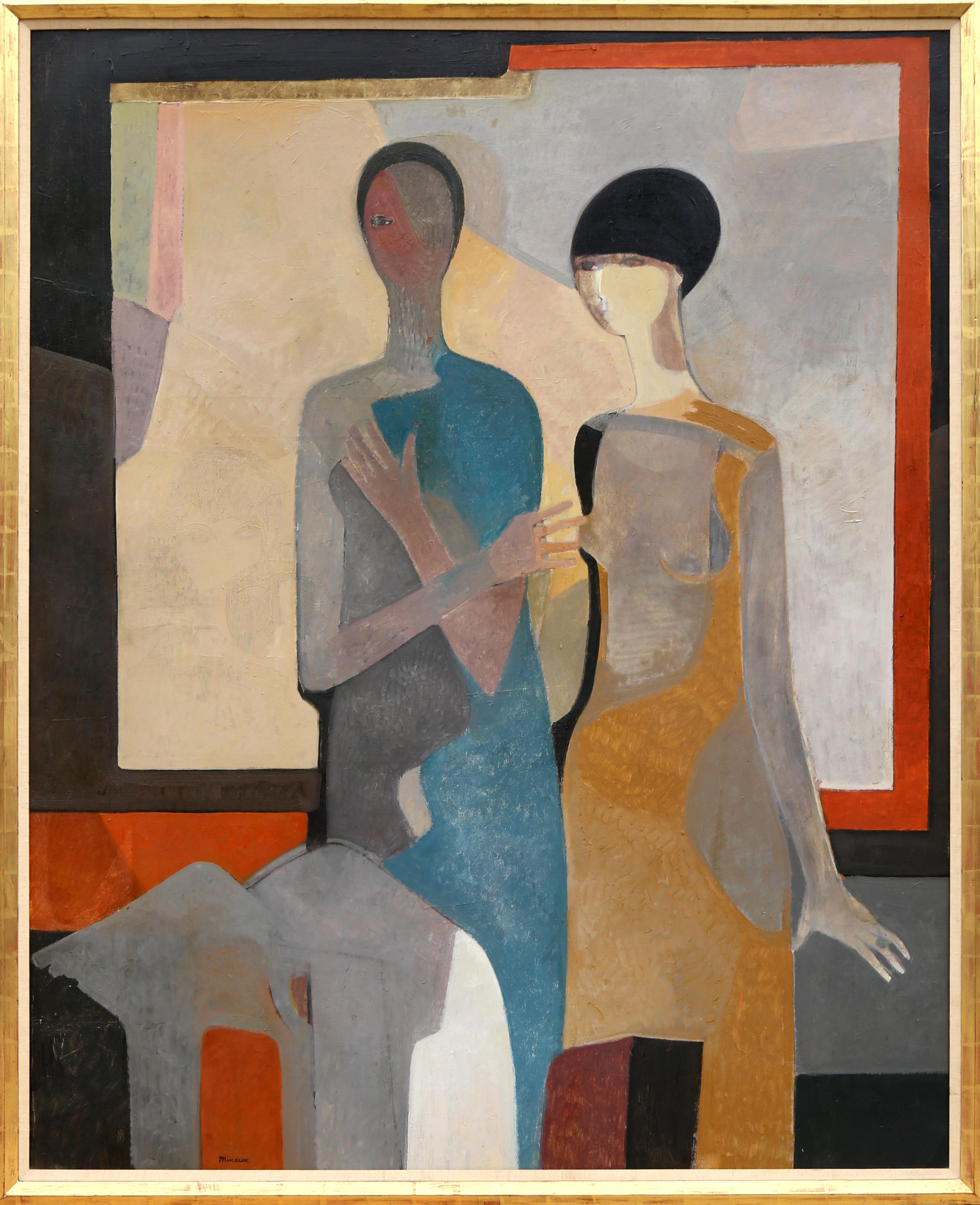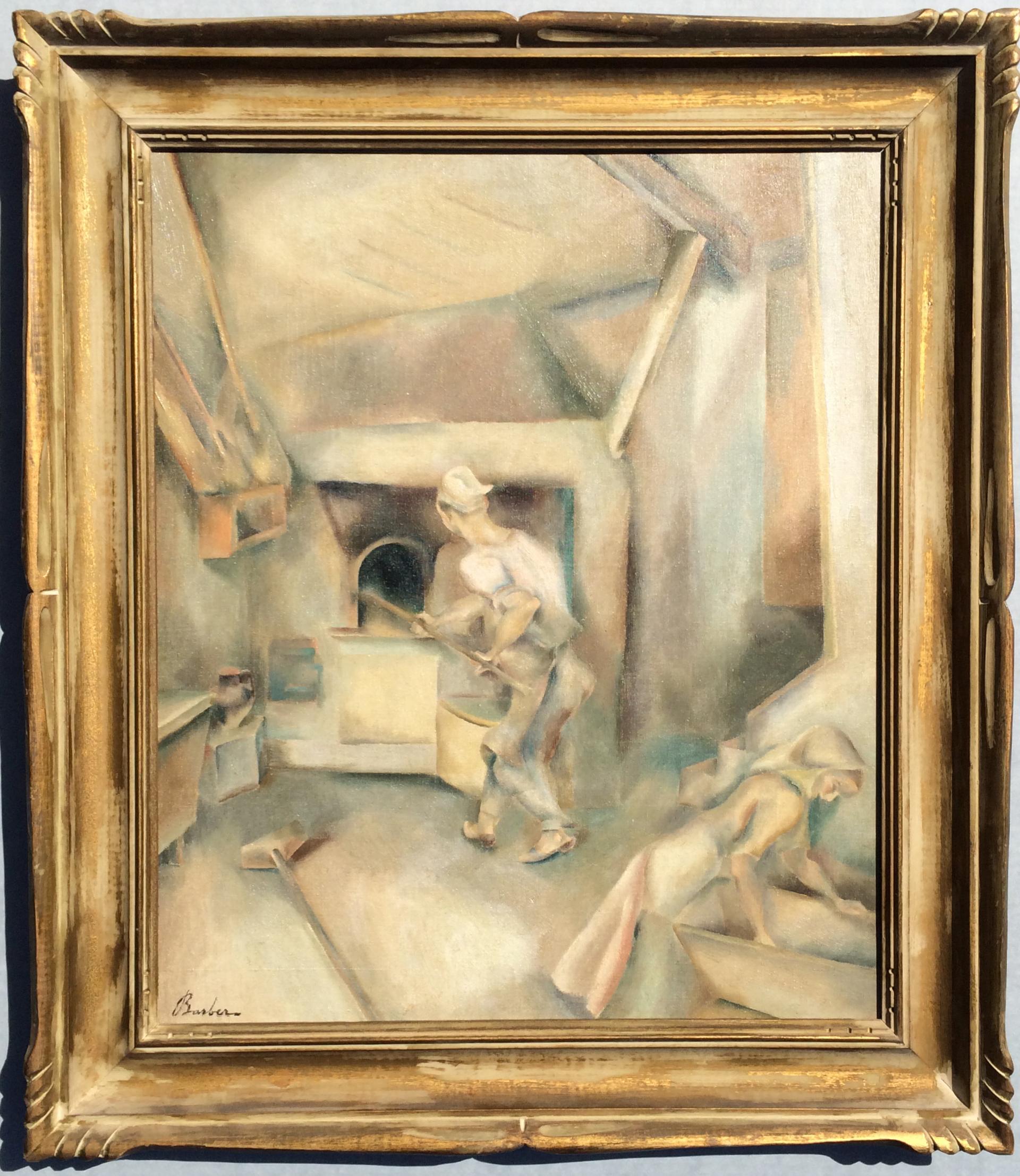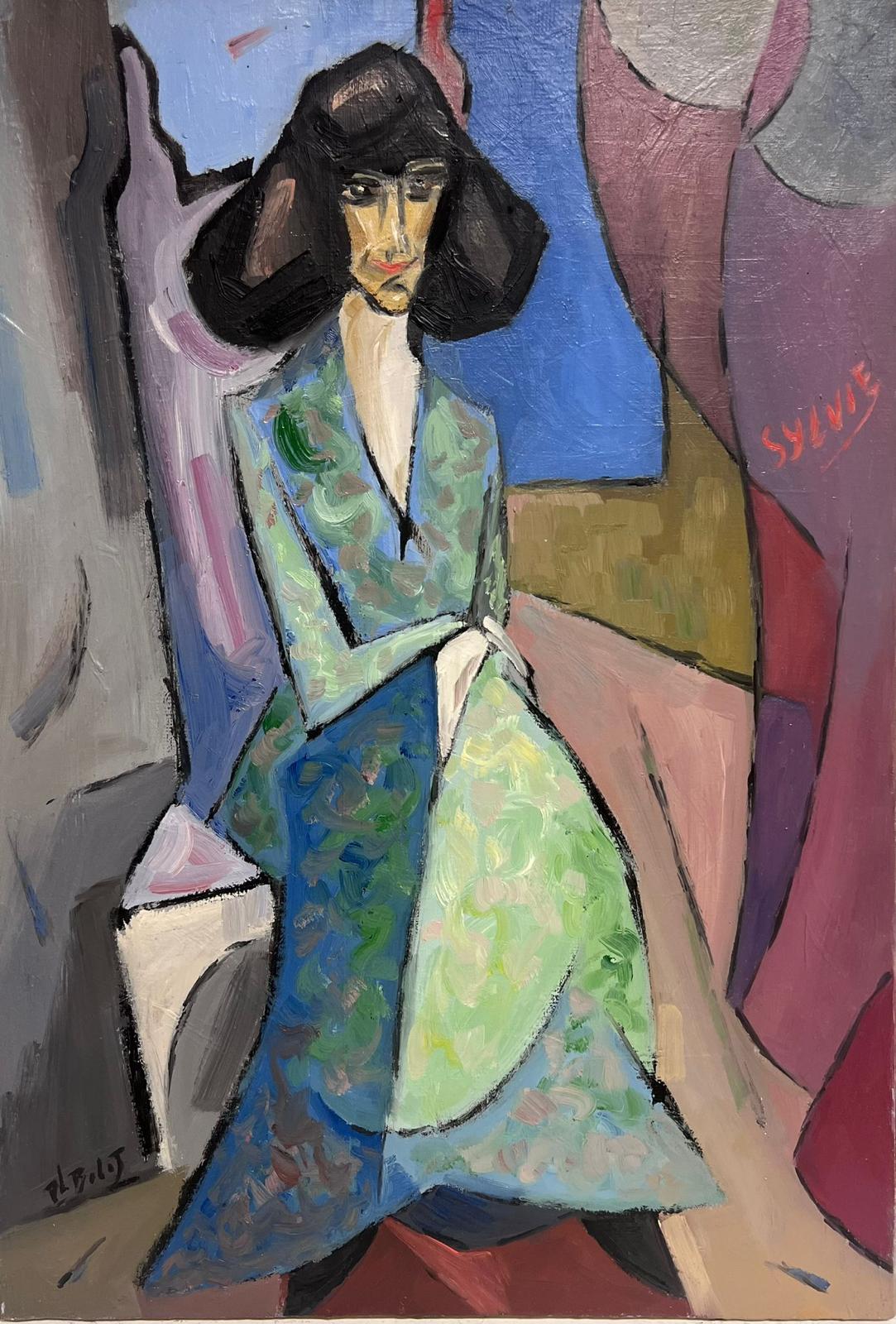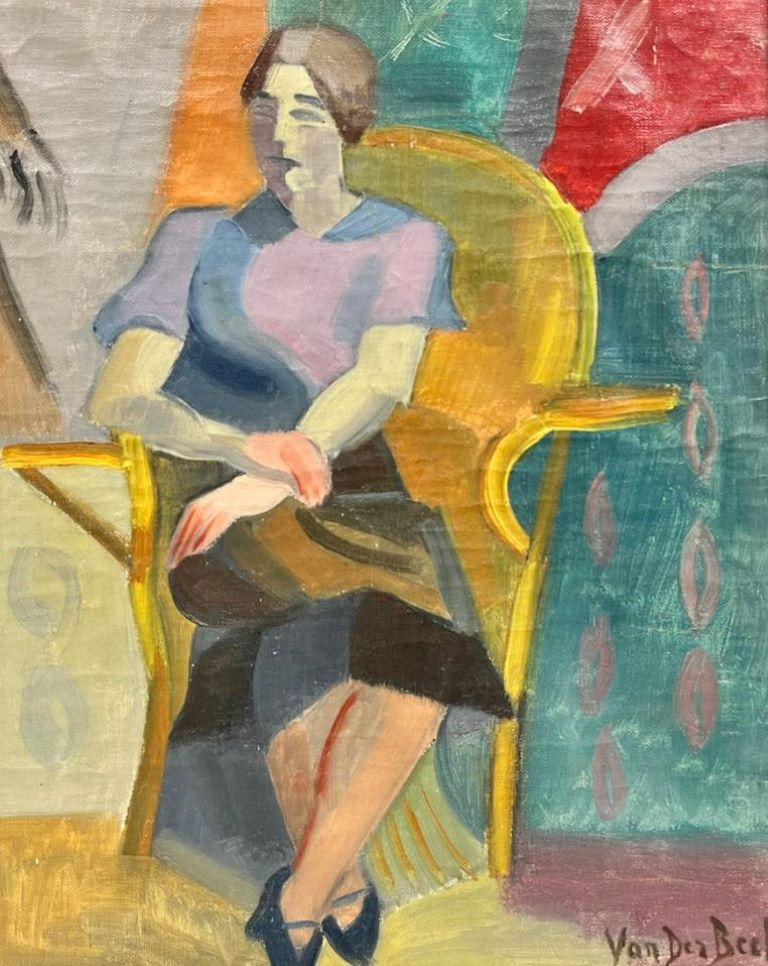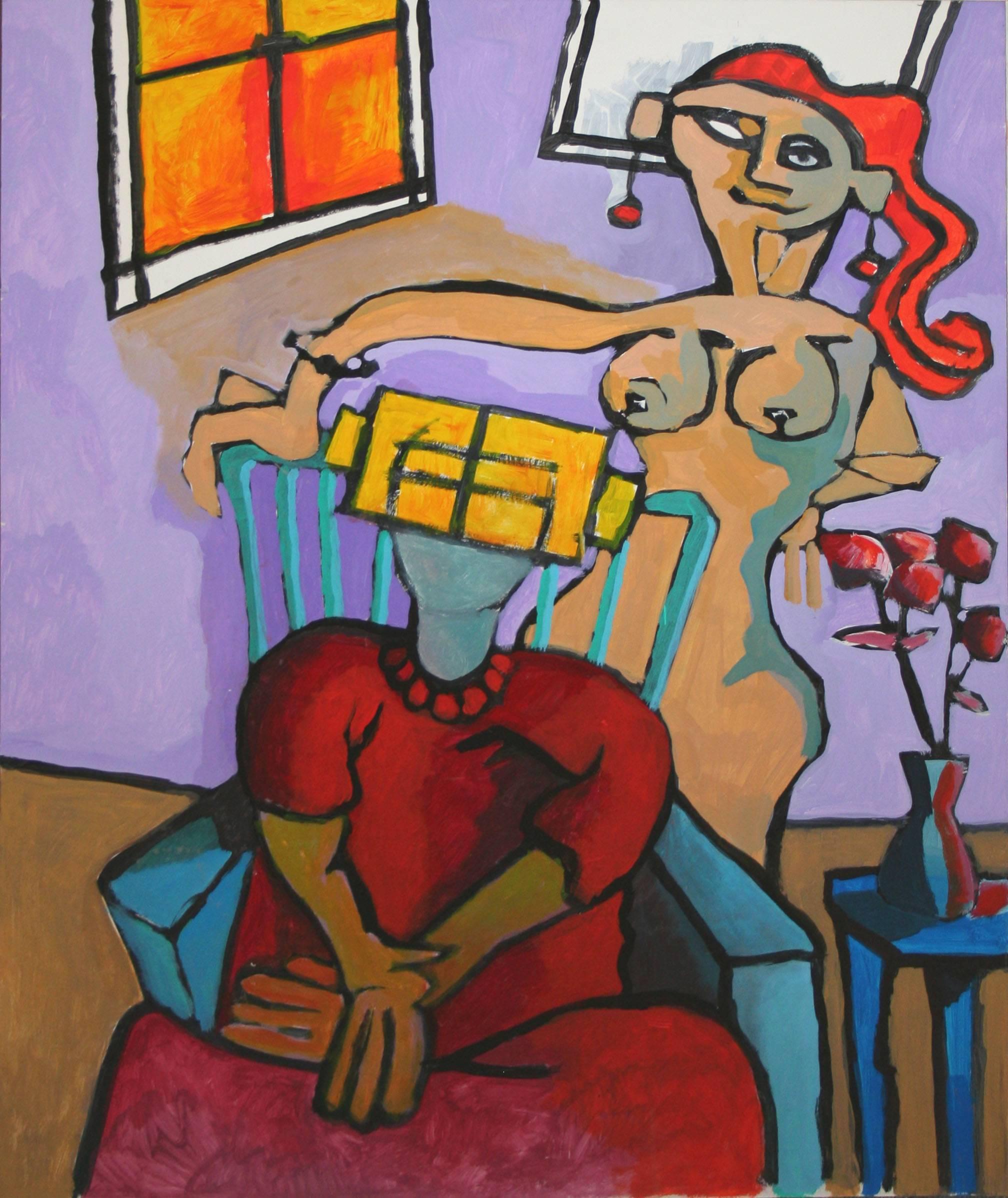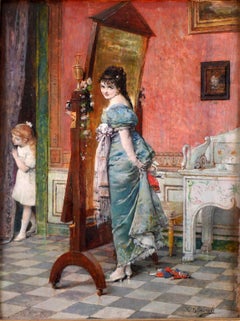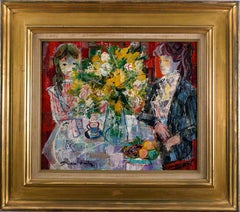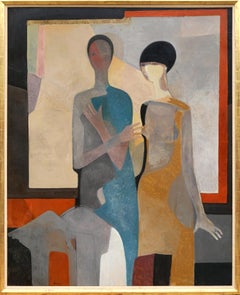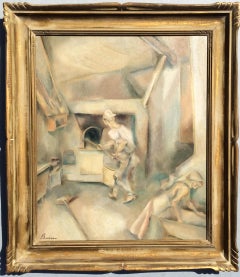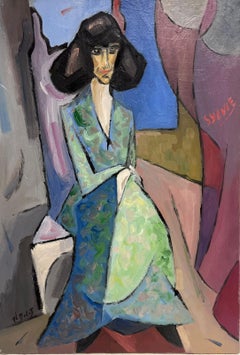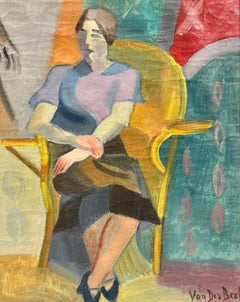Items Similar to "Les Fumeurs", 20th Century Oil on Cardboard by Spanish Artists Francisco Bores
Want more images or videos?
Request additional images or videos from the seller
1 of 12
Francisco Bores"Les Fumeurs", 20th Century Oil on Cardboard by Spanish Artists Francisco Bores1935
1935
About the Item
FRANCISCO BORES
Spanish, 1898 - 1972
LES FUMEURS
signed & dated "Borès 35" (lower right)
titled in pencil "Les Fumeurs", unfinished sketch (head), signed & dated "Bores 36" (on the reverse)
oil on cardboard
10-5/8 x 13-3/4 inches (27 x 35 cm.)
framed: 15-1/2 x 18-1/2 inches (39.5 x 47 cm.)
NOTE:
THIS WORK IS ACCOMPANIED BY A CERTIFICATE OF AUTHENTICITY ISSUED BY “ARCHIVO FRANCISCO BORES”.
BIBLIOGRAPHY:
Francisco Bores, Reasoned Catalogue, Volume I - Painting 1917-1944, Museo Nacional Centro de Arte Reina Sofia, Madrid, 2003, n° 1935 / 49, reproduced in color p. 281
PROVENANCE
Carmen Bores Collection, Francisco Bores daughter
Francisco Bores López (Madrid, May 5, 1898 - Paris, May 10, 1972) was a Spanish painter of the so-called New School of Paris.
His artistic training originated both in the Cecilio Pla painting academy, where he met Pancho Cossío, Manuel Ángeles Ortiz or Joaquín Peinado, and in the literary gatherings in Madrid related to ultraism.
At this time he made engravings and woodcuts for a large number of magazines such as Horizonte, Cruz y Raya, Index, Revista de Occidente. In 1922 he participated in the National Exhibition of Fine Arts.
In 1925 he participated in the first exhibition of the Iberian Artists Society. The limited success of this exhibition pushes him to go to Paris. In this city he shared a studio with the Spanish painter Pancho Cossío and also met Picasso and Juan Gris.
In 1927 he held his first solo exhibition in Paris. From this moment on, Bores integrates himself into the Parisian artistic environment where he will live practically his entire life. In 1928, his first exhibition in a gallery in the United States, in 1930 he exhibited again, within a group exhibition at the Museum of Modern Art in New York.
In the following years, he continued exhibiting in different galleries in Paris, such as the Georges Petit Gallery, the Bernheim Gallery and the Vavin Raspail Gallery. He also participates in several group exhibitions, highlighting the Exhibition of Contemporary Spanish Art at the Jeu de Paume Museum in Paris, he also illustrates books and art magazines such as Minotauro.
Contracts with the Zwemmer Galleries in London and Galerie Simon in Paris. Exhibitions in the United States, at the Buchholz Gallery in New York. He spent the Second World War in Saint Jean de Luz where he resumed his friendship with Matisse.
In 1947 the French State acquired, for the first time, a work by Bores, in 1949 it was the Museum of Modern Art in New York that acquired his paintings. Its exhibition activity is resumed throughout Europe: France, Germany, Denmark, Italy. His inclusion in the painters of the Louis Carré Gallery, one of the most prestigious in Paris, and therefore in the world, in those years (1954) stands out.
He continues, sporadically, to illustrate books (five linocuts "The Cry for the Death of Ignacio Sánchez Mejias" by Federico García Lorca, lithographs to illustrate the complete works of Albert Camus published by the French Imprimerie nationale in 1962). In 1969, he exhibited at the Theo Gallery in Madrid what his approach to the Spanish public represented, which was practically unaware of his work except in professional circles where, on the other hand, it was highly appreciated. In 1971 he exhibited again in this same Theo Gallery, passing away in Paris in 1972.
In Bores's work, the critic Joaquín de la Puente points out several periods:
Renewed classicism (1923-1925)
Neo cubism (1925-1929)
Painting-Fruit (1929-1933)
Interior scenes (1934-1949)
Style in white (1949-1969)
Exhibitions
Athenaeum of Madrid, 1922
Galerie Georges Bernheim, Paris 1931
Galerie Vavin-Raspail, Paris, 1933
Zwemmer Gallery, London 1935
Buchholz Gallery, New York 1939
Galerie de France, Paris 1949
Galerie Louis Carré, Paris 1954
Svensk-Franska konstgalleriet, Stockholm 1954
Galerie Louis Carré, Paris 1956
Albert Loeb gallery, New York 1960
Galerie Louis Carré, Paris 1962
Galerie Villand et Galanis, Paris 1966
Theo Gallery, Madrid, November 1971
Museums
Musée de Grenoble, France
Musée d'Art moderne de la Ville de Paris
Musée national d'Art moderne - Center Georges Pompidou, Paris
Reina Sofía National Art Center Museum, Madrid - Bores Donation
Museum of Fine Arts, Bilbao - Spain
Kunsthaus Zürich - Switzerland
Wadsworth Atheneum, Hartford, Connecticut - USA
Santander Central Hispano Foundation, Madrid - Spain
Scottish National Gallery of Modern Art, Edinburgh - Scotland
Institut Valenciá d'Art Modern, Generalitat Valenciana - Spain
Moderna Museet, Stockholm - Sweden
The Museum of Modern Art, MoMA, New York
Art and Technology Foundation, Telefónica, Madrid
- Creator:Francisco Bores (1989 - 1972, Spanish)
- Creation Year:1935
- Dimensions:Height: 10.63 in (27 cm)Width: 13.78 in (35 cm)
- More Editions & Sizes:27 x 35 cm.Price: $9,180
- Medium:
- Movement & Style:
- Period:
- Condition:
- Gallery Location:Madrid, ES
- Reference Number:1stDibs: LU1281112778382
Francisco Bores
Francisco Bores López (Madrid, May 5, 1898 - Paris, May 10, 1972) was a Spanish painter of the so-called New School of Paris. His artistic training originated both in the Cecilio Pla painting academy, where he met Pancho Cossío, Manuel Ángeles Ortiz or Joaquín Peinado, and in the literary gatherings in Madrid related to ultraism. At this time he made engravings and woodcuts for a large number of magazines such as Horizonte, Cruz y Raya, Index, Revista de Occidente. In 1922 he participated in the National Exhibition of Fine Arts. In 1925 he participated in the first exhibition of the Iberian Artists Society. The limited success of this exhibition pushes him to go to Paris. In this city he shared a studio with the Spanish painter Pancho Cossío and also met Picasso and Juan Gris. In 1927 he held his first solo exhibition in Paris. From this moment on, Bores integrates himself into the Parisian artistic environment where he will live practically his entire life. In 1928, his first exhibition in a gallery in the United States, in 1930 he exhibited again, within a group exhibition at the Museum of Modern Art in New York. In the following years, he continued exhibiting in different galleries in Paris, such as the Georges Petit Gallery, the Bernheim Gallery and the Vavin Raspail Gallery. He also participates in several group exhibitions, highlighting the Exhibition of Contemporary Spanish Art at the Jeu de Paume Museum in Paris, he also illustrates books and art magazines such as Minotauro. Contracts with the Zwemmer Galleries in London and Galerie Simon in Paris. Exhibitions in the United States, at the Buchholz Gallery in New York. He spent the Second World War in Saint Jean de Luz where he resumed his friendship with Matisse. In 1947 the French State acquired, for the first time, a work by Bores, in 1949 it was the Museum of Modern Art in New York that acquired his paintings. Its exhibition activity is resumed throughout Europe: France, Germany, Denmark, Italy. His inclusion in the painters of the Louis Carré Gallery, one of the most prestigious in Paris, and therefore in the world, in those years (1954) stands out. He continues, sporadically, to illustrate books (five linocuts "The Cry for the Death of Ignacio Sánchez Mejias" by Federico García Lorca, lithographs to illustrate the complete works of Albert Camus published by the French Imprimerie nationale in 1962). In 1969, he exhibited at the Theo Gallery in Madrid what his approach to the Spanish public represented, which was practically unaware of his work except in professional circles where, on the other hand, it was highly appreciated. In 1971 he exhibited again in this same Theo Gallery, passing away in Paris in 1972. In Bores's work, the critic Joaquín de la Puente points out several periods: Renewed classicism (1923-1925)
Neo cubism (1925-1929)
Painting-Fruit (1929-1933)
Interior scenes (1934-1949)
Style in white (1949-1969)
About the Seller
5.0
Vetted Professional Seller
Every seller passes strict standards for authenticity and reliability
Established in 1977
1stDibs seller since 2019
21 sales on 1stDibs
Typical response time: 4 hours
- ShippingRetrieving quote...Shipping from: Madrid, Spain
- Return Policy
Authenticity Guarantee
In the unlikely event there’s an issue with an item’s authenticity, contact us within 1 year for a full refund. DetailsMoney-Back Guarantee
If your item is not as described, is damaged in transit, or does not arrive, contact us within 7 days for a full refund. Details24-Hour Cancellation
You have a 24-hour grace period in which to reconsider your purchase, with no questions asked.Vetted Professional Sellers
Our world-class sellers must adhere to strict standards for service and quality, maintaining the integrity of our listings.Price-Match Guarantee
If you find that a seller listed the same item for a lower price elsewhere, we’ll match it.Trusted Global Delivery
Our best-in-class carrier network provides specialized shipping options worldwide, including custom delivery.More From This Seller
View AllFrancisco Bores, Journée claire
By Francisco Bores
Located in Madrid, ES
FRANCISCO BORES
Spanish, 1898 - 1972
JOURNÉE CLAIRE
signed and dated "Borès 34" (lower left)
oil on canvas
18 x 15 inches (46 x 38 cm.)
framed: 26 x 23 inches (66 x 58 cm.)
BIBLIOGRAPHY:
Francisco Bores, Reasoned Catalogue, Volume I - Painting 1917-1944, Museo Nacional Centro de Arte Reina Sofía, Madrid, 2003, nº 1934 / 15, reproduced in p. 231
PROVENANCE
Private Collection, Madrid
Francisco Bores López (Madrid, May 5, 1898 - Paris, May 10, 1972) was a Spanish painter of the so-called New School of Paris.
His artistic training originated both in the Cecilio Pla painting academy, where he met Pancho Cossío, Manuel Ángeles Ortiz or Joaquín Peinado, and in the literary gatherings in Madrid related to ultraism.
At this time he made engravings and woodcuts for a large number of magazines such as Horizonte, Cruz y Raya, Index, Revista de Occidente. In 1922 he participated in the National Exhibition of Fine Arts.
In 1925 he participated in the first exhibition of the Iberian Artists Society. The limited success of this exhibition pushes him to go to Paris. In this city he shared a studio with the Spanish painter Pancho Cossío and also met Picasso and Juan Gris.
In 1927 he held his first solo exhibition in Paris. From this moment on, Bores integrates himself into the Parisian artistic environment where he will live practically his entire life. In 1928, his first exhibition in a gallery in the United States, in 1930 he exhibited again, within a group exhibition at the Museum of Modern Art in New York.
In the following years, he continued exhibiting in different galleries in Paris, such as the Georges Petit Gallery, the Bernheim Gallery and the Vavin Raspail Gallery. He also participates in several group exhibitions, highlighting the Exhibition of Contemporary Spanish Art...
Category
1930s Cubist Interior Paintings
Materials
Canvas, Oil
"The Mandolin Serenade", 19th Century Watercolour on Cardboard by Giménez Martín
Located in Madrid, ES
JUAN GIMÉNEZ MARTÍN
Spanish 1855 - 1901
THE MANDOLIN SERENADE
signed & located "Gimenez-Martin, Roma" lower left
watercolour on cardboard
21-1/4 x ...
Category
1880s Realist Figurative Paintings
Materials
Watercolor, Cardboard
"Playing hide and seek", 19th Century Oil on Panel by Vicente Palmaroli, Spanish
Located in Madrid, ES
VICNTE PALMAROLI y GONZÁLEZ
Spanish, 1834 - 1896
PLAYING HIDE AND SEEK
signed "V. Palmaroli" (lower right)
oil on mahogany panel
17-3/4 x 13-1/2 inches (45 X 34 cm.)
framed: 25-1/4 X 21-1/4 inches (64 X 53.7 cm.)
PROVENANCE
Leslie Hindman Inc., Auctionners
Private Collector, Madrid
Oil on table by Vicente Palmaroli...
Category
Late 19th Century Romantic Interior Paintings
Materials
Oil, Wood Panel
"Interieur aux Fleurs Jaunes" 20th Century Oil on Canvas by Emilio Grau Sala
By Emilio Grau Sala
Located in Madrid, ES
EMILIO GRAU SALA
Spanish, 1911 - 1975
INTERIEUR AUX FLEURS JAUNES
signed "Grau Sala" (lower left)
signed again, located, dated and titled "Grau Sala, Paris 61, Interieur aux fleurs jaunes" (on the reverse)
oil on canvas
15 x 18-1/4 inches (38 x 46 cm.)
framed: 23-1/2 x 26-1/2 (59.5 x 67 cm.)
PROVENANCE
Private Parisian Collection
Interieur aux fleurs jaunes
This interior with two female figures where also the plans made in different colors are drawing the composition.
The abundant pictorial material distributed in geometric portions, gives life to the tablecloth and mother and daughter figures, in black and white colors of the jacket, while the black line takes care of the environments so as not to separate them.
The fruit bowl and flowers give a cheerful touch with their pastel tones.
Emilio Grau Sala came from a family of artists. He was born in Barcelona in 1911 and his father, a good cartoonist, had been one of the promoters of the "Salon des Humanistes" and made his exhibitions normally in "Sala Parés", Barcelona.
His first works were exhibited at the Salon des Independents. In the years 1930-33 he had painted under the influence of Cubism, especially that of Torres García. It is from that time a painting of the port of Barcelona, geometric and structural, which completely anticipated what would later be his work. His personality began fully painting watercolors and oils with a certain fantasy character, with a point of decorative instinct and themes full of naivety and grace. Romantic interiors, paddocks, port scenes, sailors, etc.
Grau Sala was essentially a Mediterranean painter, son of post-impressionism and enriched with French painting of the last fifty years. Mediterranean because his work has the color and light of that land.
He understood and assimilated impressionist painting very well, and for that reason he was never subject to the modules of a formulist realism, nor the sexigencias of the forms.
In Paris he found the best environment to give us a fruitful and intense work, because he could use the expressive potential of French art to enrich it.
All this made him a very esteemed artist everywhere where his work was known. He was also very often required to illustrate books and publications in Paris. Also his posters were very successful.
He painted a large number of subjects, but perhaps the theme of horse racing is where you can see in a very clear way the joyful and optimistic life that was lived at that time. In this fabric there is an explosion of juicy and vivid colors full of ingenuity and simplicity in its composition. Only a teacher could turn the complicated into something simple and beautiful. Before this work we feel a deep emotion, the emotion of before starting a horse race. Joy and nervousness at the same time. Especially since it is a direct emotion. There are no intermediaries between our eyes and what the work intends to tell us. This is precisely what seduces and catches us of this painting.
His works can be found in the Museums of the Villa de Paris, L'Ile de France Museum, at the Château de Sceaux, Honfleur Museum, La Rochelle Museum, Barcelona Museum...
Category
1960s Fauvist Interior Paintings
Materials
Canvas, Oil
"Lady in yellow", 19th Century oil on panel by Rogelio de Egusquiza y Barrena
By Rogelio de Egusquiza y Barrena
Located in Madrid, ES
ROGELIO DE EGUSQUIZA Y BARRENA
LADY IN YELLOW
signed "R. Egusquiza" (lower right)
oil on panel
28-5/8 X 20-3/4 inches (72.5 X 52.7 cm.)
framed: 32-5/8 X 24-3/4 inches (82.5 X 62.5 cm.)
Rogelio de Egusquiza y Barrena (1845 – 10 February 1915) was a Spanish painter, known for his friendship with the German composer Richard Wagner, whose works he helped make familiar in Spain
He was born in El Astillero, into a well-to-do family. He studied in Madrid and with Léon Bonnat at the École des Beaux-Arts in Paris. In 1868, after travelling and participating several times in the National Exhibition of Fine Arts, he returned to Paris and settled there. At first, he painted historical scenes, but later turned to genre scenes and portraits in the Academic style.
Following the death of Marià Fortuny, he moved to Rome at the invitation of the Madrazos, Raimundo and Ricardo, taking Fortuny's place at their studio through 1875 and attending classes at the Spanish Academy in Rome.
He heard Wagner's music for the first time in 1876, after returning to Paris. Three years later, he travelled to Munich to hear a performance of The Ring of the Nibelungen. His enthusiasm for what he heard led him to go to Bayreuth, where he introduced himself to Wagner and became his friend. In the following years, he and Wagner got together again several times; in Venice (1880), Berlín (1881) and Bayreuth (1882); where he was a guest at the premiere of Parsifal.
After his first meeting with Wagner, he decided to devote his career to doing works on Wagnerian themes; mostly portraits of the characters rather than specific scenes. During his visits to Germany, he also created portraits of Arthur Schopenhauer (posthumous) and King Ludwig II...
Category
1880s Realist Interior Paintings
Materials
Oil, Panel
Mère et fillette au bouquet de fleurs
By Emilio Grau Sala
Located in Madrid, ES
EMILIO GRAU SALA
Spanish, 1911 - 1975
MÈRE ET FILLETTE AU BOUQUET DE FLEURS
signed "Grau Sala" (lower left)
signed, located and dated “GRAU SALA / PARIS 1963” (on the reverse)
oil on...
Category
1960s Post-Impressionist Figurative Paintings
Materials
Canvas, Oil
You May Also Like
Two Women in Interior, Modern Cubist Painting by Andre Minaux
By Andre Minaux
Located in Long Island City, NY
Two Women
Andre Minaux, French (1923–1986)
Date: circa 1970
Oil on Canvas, signed lower right
Size: 77 x 61 in. (195.58 x 154.94 cm)
Frame Size: 80.5 x 65 inches
Category
1970s Cubist Figurative Paintings
Materials
Canvas, Oil
Bread Bakers oil painting by John Barber
By John Barber
Located in Hudson, NY
Measures 22" x 18" and framed 27" x 24" x 3".
About this artist:
Born in Galatz, Romania, John Barber became a modernist painter of figures and scenes of...
Category
1930s Cubist Figurative Paintings
Materials
Canvas, Oil
1980's French Cubist Modernist Signed Oil Painting Fashionable Lady in Interior
Located in Cirencester, Gloucestershire
Sylvie
by Paul-Louis Bolot (French 1918-2003)
signed & dated 1981
signed oil on canvas
canvas: 22 x 15 inches
original oil painting
condition: very good an...
Category
20th Century Cubist Figurative Paintings
Materials
Oil, Canvas
1930's French Cubist Signed Oil Lady in Red Seated on Golden Chair in Interior
Located in Cirencester, Gloucestershire
Artist/ School: by Henri Van Der Beck (French 1886-1956), signed lower right
Title: Portrait of a lady seated on a golden yellow chair within an interior...
Category
Mid-20th Century Cubist Figurative Paintings
Materials
Oil
Contemporary Large-Scale Cubist Figurative Abstract Lavender Interior Scene
By Michael William Eggleston
Located in Soquel, CA
Contemporary Large-Scale Cubist Figurative Abstract Lavender Interior Scene
Bursting with bright colors and whimsical energy, this contemporary figurative abstract painting by San ...
Category
Early 2000s Fauvist Figurative Paintings
Materials
Cardboard, Oil
1940s New York Interior -- An Evening Scene of Artist and His Wife
Located in Soquel, CA
1940s New York Interior -- An Evening Scene of Artist and His Wife
Wonderful moody 1940s New York interior and figurative oil painting in Ashcan Schoo...
Category
1940s Ashcan School Interior Paintings
Materials
Canvas, Oil, Cardboard
$1,200 Sale Price
20% Off
Recently Viewed
View AllMore Ways To Browse
Swiss 20th Century Artists
20th Century French Woodcuts
Large Danish Oil Painting
Neo Cubism
Fruit Painting Spanish
Jeu De Paume
German Color Woodcut
Fruit Engraving
Picasso Signed Linocut
Spanish Oil Fruit
Luz Vintage
Cubist Danish Painting
Matisse Linocut
Saint Jean De Luz
Picasso Carmen
World War 2 Sketches 1944
P Sanchez
Manuel Lopez
